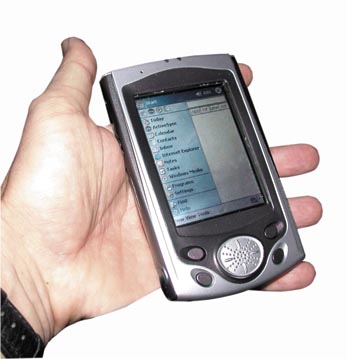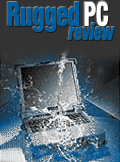Casio Cassiopeia E-200
A new breed of Cassiopeias
October 4, 2001 --
Of all the original providers of Pocket PCs, my guess is that Casio was hardest
hit by Microsoft's decision to make the Pocket PC 2002 platform available only
for ARM-based processors. Casio, after all, had by far the largest and most
varied lineup of Pocket PCs, ranging from the elegant EM-500, to the powerful and
expandable flagship E-125--the handheld that defined the modern era multimedia
PDA--to the EG-80 and 800 ruggedized models with snap-on batteries, and finally
the IT-70 and 700 industrial Pocket PCs. And that's not even counting some
Japanese market products like the E-700, E-707, and E-750. What all of those
splendidly polished devices have in common is that they are based on the NEC
VR41xx series of processors and thus won't run Pocket PC 2002, not now and not
ever. Quite a blow if you ask me. It's not that those models will all be
obsolete, but it's a bit like sitting on a lineup of perfectly good PCs that run
Windows 98 but not Windows XP.
 The result of this predicament is twofold. First we have the Casio BE-300 which
we introduced in our last issue. The BE-300 '"Pocket Manager" is a PDA that runs
the latest version of Windows CE, 3.0, but does not use the Pocket PC software.
Instead, it has its own set of applications and its own user interface.
The result of this predicament is twofold. First we have the Casio BE-300 which
we introduced in our last issue. The BE-300 '"Pocket Manager" is a PDA that runs
the latest version of Windows CE, 3.0, but does not use the Pocket PC software.
Instead, it has its own set of applications and its own user interface.
The second is the subject of this preview, the Cassiopeia E-200. The E-200 is the
first of what will presumably be a new line of Casio Pocket PCs, a line that's
based on the Microsoft-mandated ARM processors. As of the deadline for this issue
of Pen Computing, we haven't had a chance to review the new E-200 in detail. We
did see it at Microsoft's '"Mobility Technical Forum" in Seattle where we learned
all about Pocket PC 2002, hardware, software, and future directions. While most
of our esteemed colleagues took liberal advantage of a delicious buffet and free
bar at Seattle's awesome Experience Music Project, we passed on the goodies and
pawed the exciting new hardware instead.
So what can we say about the E-200? Like seemingly everyone else, Casio is now
following the trail blazed by the original Compaq iPAQ. Gone is, for example, the
Casio-trademark razorsharp TFT display. In the E-200 it's been replaced by a
3.5-inch indoor/outdoor-viewable reflective color LCD. It's a good, competent
display and, judging by the iPAQ's success, what the market wanted. Personally, I
hope that Casio eventually will offer consumers a choice between its fabulous
standard TFT and the reflective display, just like some notebook and tablet PC
manufacturers do. I am also a bit disturbed by a general move to the smaller 3.5
inch format. Of all the new Pocket PCs, only Compaq still uses the larger 3.8
inch display.
Needless to say, the E-200's 206MHz StrongARM processor provides the lively
performance we've come to expect from PDAs built on that platform. And, as
mandated by Microsoft, the E-200 has 32MB of Flash ROM which means that it can
easily be upgraded to future versions of Pocket PC. The device comes with a
generous 64MB of RAM, and also offers unparalleled expansion capabilities.
We're not just talking a single expansion slot here. No, the E-200 comes with
both CF card and SD card slots. The CF Card slot on top of the unit can
accommodate Type I and the thicker Type II cards. And the SD slot on the side can
handle both MMC and SD cards. But that's not all. Like the iPAQ, the Cassiopeia
E-200 line also has optional expansion sleeves that can accommodate PC Cards and
also offers replaceable batteries.
Like earlier Cassiopeias, the E-200 has a cleverly designed cradle. Unlike the
new iPAQ, the E-200 can be charged via the cradle but it still has a separate
standard AC/DC jack for when you don't want to take the cradle along. The cradle
itself has a USB connector, but Casio also offers separate serial and USB cables
so that, again, you don't have to take the cradle along on a trip. Casio also
claims that the E-200 will be able to control such diverse devices as printers,
projectors, CD-ROM drives, keyboards and mice. I can see the merit for at least
some of those combinations, though I haven't seen the software for them yet.
Like older Cassiopeias, the E-200 has a replaceable battery instead of a fixed
internal power pack. It uses Li-Ion technology and Casio indicates 10 hours of
typical use.
From a design point of view, the E-200 breaks new ground for Casio. It doesn't
really resemble any of the earlier models which all had the navigation disc on
the left and three function keys on the right, an arrangement that goes all the
way back to the 1993 GEOS-based Casio Z-7000 PDA. Instead, the E-200 sports the
by now almost ubiquitous central navigation pad flanked by two application
buttons on either side. The sole carryover is the old rocket ship icon that also
goes all the way back to the 93' Z-7000. There is still an old-style
rocker/action control on the left side of the device, flanked by the MMC/SD card
slot and an audio jack.
Measuring just 3.25 x 5.1 x 0.68 inches and weighing a mere seven ounces, the
E-200 is significantly smaller and lighter than the E-125 and even undercuts the
svelte EM-500. This is clearly not last year's Pocket PC. This device is part of
a new generation of Pocket PCs, a generation that for now uniformly marches to
the beat of the Microsoft drummer.
Compared to the competition, the Cassiopeia E-200 offers some significant
expansion capability advantages. Its dual slot arrangement is only matched by the
new Toshiba Pocket PC, but the Toshiba doesn't, to the best of my knowledge, have
optional expansion sleeves. The design and layout of the E-200 is neat and clean,
and everyone will appreciate the more compact size and weight compared to older
Cassiopeias. I do miss that great, vibrant (and larger) color TFT that graced all
earlier color Cassiopeias, but outdoor readability is simply a must these days.
So the preliminary impression is a good one. Stay tuned for a full review! -
– Conrad H. Blickenstorfer
| Processor |
Intel StrongARM 206 MHz |
| OS |
Pocket PC 2002 |
| Memory |
64MB RAM, 32MB Flash ROM |
| Display |
3.5-inch 64k color 240 x 320 pixel reflective TFT LCD |
| Digitizer |
Pressure-sensitive panel |
| Storage |
Internal RAM, MMC/SD and CF Type II storage cards, expansion jackets |
| Size |
3.25 x 5.12 x 0.68 inches |
| Weight |
7.1 oz |
| Power |
Li-Ion pack |
| Interface |
USB/Serial, Irda, stereo audio, mic |
| Options |
Expansion sleeves, cradles, cases |
| Price |
NA |
| Contact |
Casio casio.com |
|


 The result of this predicament is twofold. First we have the Casio BE-300 which
we introduced in our last issue. The BE-300 '"Pocket Manager" is a PDA that runs
the latest version of Windows CE, 3.0, but does not use the Pocket PC software.
Instead, it has its own set of applications and its own user interface.
The result of this predicament is twofold. First we have the Casio BE-300 which
we introduced in our last issue. The BE-300 '"Pocket Manager" is a PDA that runs
the latest version of Windows CE, 3.0, but does not use the Pocket PC software.
Instead, it has its own set of applications and its own user interface.